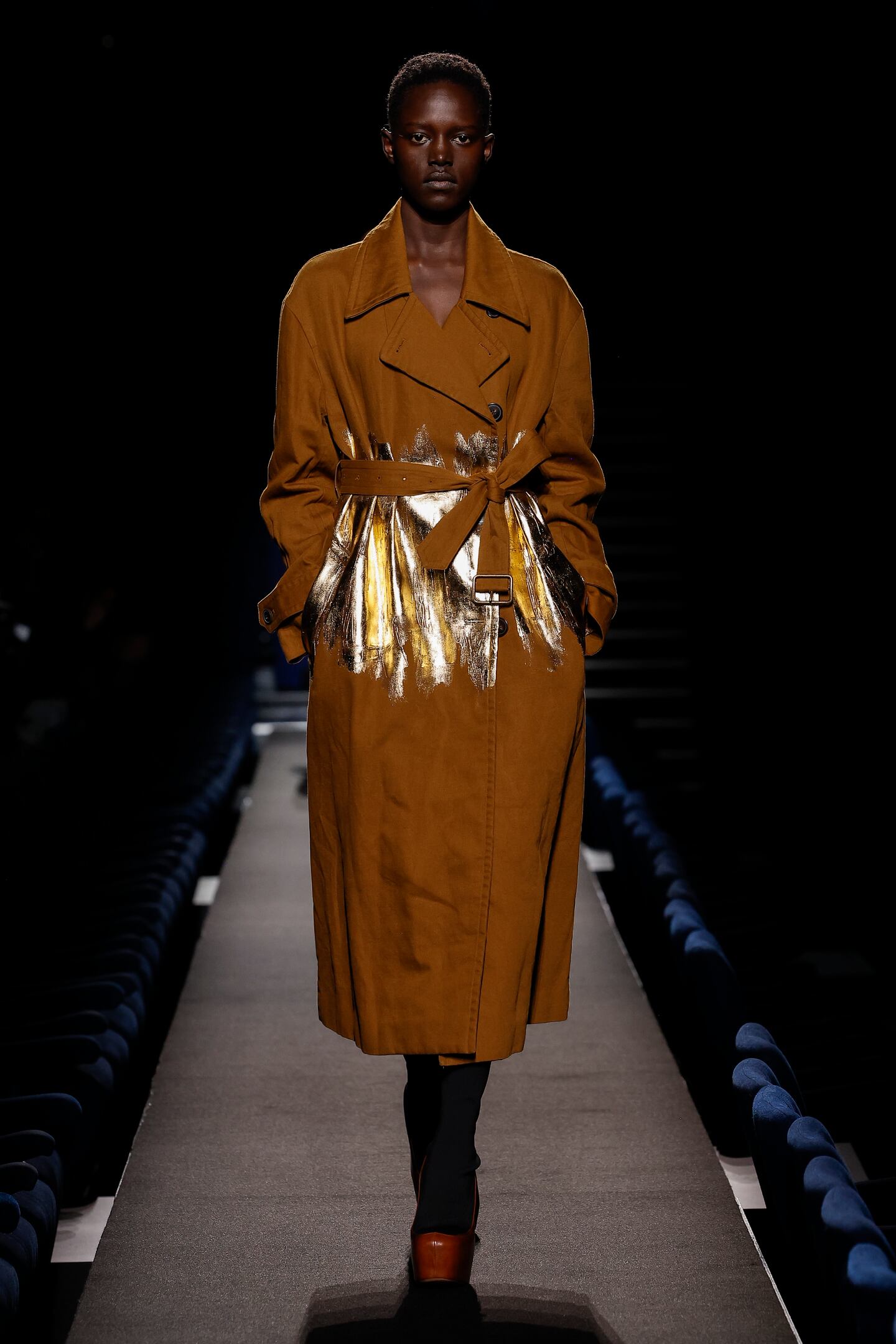
The Business of Fashion
Agenda-setting intelligence, analysis and advice for the global fashion community.

Agenda-setting intelligence, analysis and advice for the global fashion community.

PARIS — The best antidote to disposability in fashion is to make clothes precious, so you don’t feel the urge to replace them. But what makes clothes precious? Nothing as banal as a price tag, though a beautiful fabric and make clearly help. I’m a dreamer, so it’s the life of cherished clothes that makes them precious to me.
The Japanese put broken pottery back together with gold, celebrating the flaws to make the object even more beautiful. They call it kintsugi. Dries Van Noten practised a kind of kintsugi with clothes on Wednesday, not only because gold was leafed and threaded and woven throughout the collection, but because there were dozens of hidden details that gave a subtle new life to coats, jackets, dresses. It was a beautiful show, with that particular combination of sobriety and opulence that was a distinct signature for the designer in the 1990s. Though he doesn’t like looking back, there are kids in his studio who weren’t born then and their enthusiasm motivated him to reassess his past. Bless them, because we were the beneficiaries.
0 of 59
Dries is a past master of contrast, most fundamentally masculine and feminine. The first look was a pinstripe suit leavened with a silk ruffle that curled down the outside seam. Later, a raw-hemmed tweed dress with fabric bunched into a ruffle running down the front. This resonated, like something artisanal you could do yourself. Personalised. Precious. Dries talked about the contrast between masculine fabrics and “flimsy little silk things somebody has drawn on with pencils or painted little flowers on.” The silhouettes were strict, elongated by chunky platforms, but the fabrics had the glint and lure of a treasure trove. A too-big coat was drawn in at the waist with a cluster of gold bugle beads. The waist of another coat in finest English wool was wrapped in gold leaf (Van Noten used a similar effect in a men’s collection years ago). Gold also leafed the entire front of a camel blazer. Elsewhere, it was as unassuming as the thread that mended a broken buttonhole.
That kind of intimacy underpinned the collection. Fold back the lapel on a plain grey coat to find a hidden insert of gorgeous jacquard. Peel the layers of a dress — mousseline, organza, gazar — and find a hem of French lace. For Dries, it was always about the private pleasure, the complicity between clothes and the person wearing them. The fundamental symbiosis of fashion. He reinforced that point here with ardent musical accompaniment by drumming virtuoso Lander Gyselinck. “He becomes one with the drum when he plays,” said Van Noten, “and that’s what I like with clothes and the person who wears them. One identity.”
ADVERTISEMENT
Jun Takahashi’s pursuit of preciousness takes an opposite but equally enthralling path. Multiple identities, rather than the single symbiosis. Wednesday’s was wrapped around Two-Tone, the ska-based post-punk pop sensation that swept the UK at the end of the 1970s. We’ve come to expect the obscure/arcane musical reference fully realised for the here and now by Takahashi in minutely observed detail, and so it was with his new collection, which was, not incidentally, titled Enjoy Yourself, after a song by the Specials, ska’s star band. The music was a memory of joyous teenage for him.
0 of 48
So was the immaculately evoked, sharp, severe tailoring of the suits worn by ska stars like Pauline Black. Takahashi did a little freeforming with the black and white check that shaped Two-Tone’s visual identity, adding a brown and cream co-relative lifted from an album sleeve by German electronic musician Manuel Göttsching. You could go down a rabbit hole with Jun, so simply accept that his fandom is inspirational in its breadth and sincerity (there are dozens of his playlists on Spotify that will testify to that).
The wonder of all this was severely clouded in December, during Takahashi’s design process, when both Terry Hall, lead singer of the Specials, and Manuel Göttsching passed away. What are the odds of that happening? Death unsurprisingly added a mordant note to the show: “Enjoy yourself, it’s later than you think.” A recurring motif was a beaded, claw-like hand, a memento mori. A trench coat passed by, encyclopaedically embroidered with downbeat slogans. “There are people who act like monsters and monsters who act like people.”
The Specials’ biggest hit was a song called “Ghost Town,” released in the darkest days of Margaret Thatcher’s unravelling of the fabric of British society. The same thing is happening now, all over the world. Takahashi is a sensitive soul, acutely tuned to such developments. His collection spun off into a gorgeous sequence of protective puffa coats, including a tuxedo/duvet hybrid that could dress the last red carpet before humanity’s closing curtain. Were the models weeping blood?
Designers Maria Grazia Chiuri and Anthony Vaccarello proposed clothes for harder times, writes Tim Blanks.
Matthieu Blazy’s collection was a joyous and ingenious celebration of pure craft, writes Tim Blanks.
Van Noten and Jun Takahashi prove that an actual fashion show is still the best, writes Tim Blanks.

Tim Blanks is Editor-at-Large at The Business of Fashion. He is based in London and covers designers, fashion weeks and fashion’s creative class.
From where aspirational customers are spending to Kering’s challenges and Richemont’s fashion revival, BoF’s editor-in-chief shares key takeaways from conversations with industry insiders in London, Milan and Paris.
BoF editor-at-large Tim Blanks and Imran Amed, BoF founder and editor-in-chief, look back at the key moments of fashion month, from Seán McGirr’s debut at Alexander McQueen to Chemena Kamali’s first collection for Chloé.
Anthony Vaccarello staged a surprise show to launch a collection of gorgeously languid men’s tailoring, writes Tim Blanks.
BoF’s editors pick the best shows of the Autumn/Winter 2024 season.